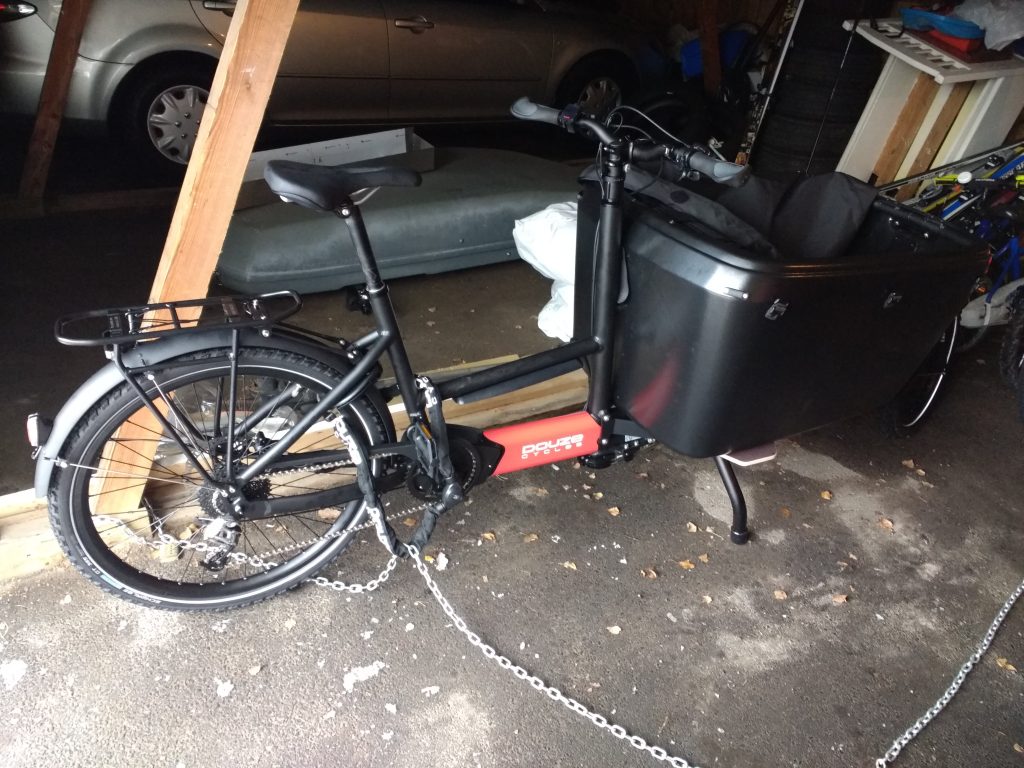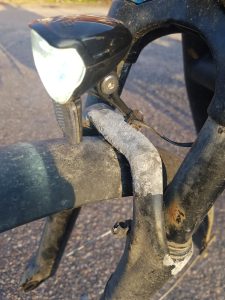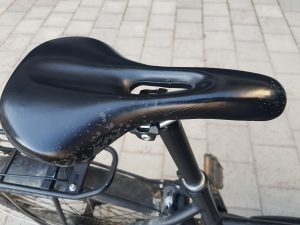Introduction
I am reviewing the “DOUZE G4e” two-wheeled electric cargo bike (“long-john”) which I have been sharing with other family members between February 2021 and December 2023, but do not own anymore. I am writing this review to drive forward the development of the DOUZE G4e model in particular and electric cargo bikes, which I consider the future of (sub)urban transport, in general. The review may also support the purchase decision of potential buyers of an electric cargo bike.
To give context to this review, I would like to mention that I have been using or testing the following cargo bikes (bio or electric):
- Trikes (with/without tilting technology), e.g. WINTHER Kangaroo, Butchers & Bicycles MK1-E Gen. 3 Vario, other brands
- Long-johns, e.g. DOUZE G4, URBAN ARROW, RADKUTSCHE RAPID, RIESE & MÜLLER PACKSTER
- Long-tails, e.g. TERN GSD
Summary
The Douze G4e is a very stylish, ergonomic, spacious and stable electric cargo bike, with very smooth integration of the electric engine support. However, the bike requires considerable maintenance and repairs (e.g. gears, engine, battery) which is especially annoying without a local bike shop within walking distance. In case of more complex repairs (e.g. engine, battery), it requires sending expensive (e.g., engine) or potentially dangerous (e.g., lithium battery) goods via specific, expensive postal services, which may take several weeks during which the bike is not operational.
In Nordic climates, two-wheeled cargo bikes may be less safe to ride if roads are covered with snow or ice, and an electric cargo trike may be preferable for robust all-year round operation. However, in my opinion the additional joy of riding a two-wheeled cargo bikes during spring, summer and autumn outweigh the issues during winter. A two-wheel bike is much faster and safer to drive during the warmer seasons because it is easier to compensate bumpy or uneven roads by steering and shifting one’s body weight. Moreover, in my experience cycling with spiked wheels during winter is sufficiently safe to commute and transport kids on a daily basis.
Details
- Bike: Douze G4e, two wheel cargo bike,
- Frame: Traveller (low frame), Colour: Black
- Engine: Brose Drive S middle-engine 36V, 250W, 90 Nm,
- Battery: 36V, 17,5 Ah, 635 Wh Lithium ion batterie with lock and charger
- Brakes: Disc Brakes Gemini Tektro SL
- Equipment:
- black Box V2 800 + Hardcover
- Child Seat Black Box
- Canopy Black Box
- Ringlock ABUS 5850 Pro Shield
- Rear carrier Racktime Shine Evo
- Retail shop:
- Bulten Bike, https://bultenbike.se
- Fotos: Douze G4, https://bultenbike.se/douze-g4e-black-box/
Figure 1: Douze G4e

Strengths
The DOUZE G4 has the finest, ergonomic cycling experience regarding sitting position, steering, smoothness and power of electric support of pedaling. The cargo box (with tent) is spacious and large enough for two kids up to about 8 years and protects against cold wind and rain.
Weaknesses
- The battery is not working reliably:
- During summer 1 out of 20 cases the battery does not start or charge, during winter in 1 of 7 cases it does not start or charge. It may also start after a few minutes of cycling. The battery may start charging (green flashing light), but then stop charging (red flashing light), which creates frustration when the battery is not usable after a night of charging. The issue was present from the start, but just not annoying enough to go into conflict with the bike shop or DOUZE (see below).
- If the battery is not working also the light is not working, which is not only annoying but also unsafe. I recommend to have emergency battery lights (front and back) with you in the box for such situations. I have been in (rare, but still) situations where I had to cycle back from downtown in the dark for 8km with my 8-year old daughter in the box without electric pedaling support and without light (!) after I had fully charged the battery when leaving home, ie the fully charged battery failed after 8km.
Note: For the design of electric bikes, I recommend to generate the power for the lights mechanically with a hub dynamo, which also works if the battery fails.
- Gears and chain are under-dimensioned:
- The gears and chain are just standard mountain bike equipment. The additional support by the electric engine creates additional wear and tear, especially on the small cogs (high gears) with few teeth. Therefore, the cog and chain needs to be replaced every year.
- Replacing the belt of the engine is a service disaster.
- After 2 years the belt in the engine broke which took the bike out of service for about two months because a local bike mechanic had to remove the engine from the bike, I had to sent the engine to the retailer, the retailer had to replace the belt and send it back again, and a local bike mechanic had to install the engine again. The multiple problems were:
- I could not take out the engine myself because I did not have the tools. I did not know which tools to buy. The retailer and other bike shops were not helpful in giving me advice which tools I needed.
- The bike shops I contacted in Uppsala (https://www.velotek.se, https://www.elcykelpunkten.se) both did not know the brand of the engine “Brose” and estimated costs of 2-3h x 600SEK/h ~ 1200 SEK to 1800SEK for taking the engine out of the bike frame (and also to put it back again), ie 2400 to 3600SEK in total (240 to 360EUR).
- Taking a electric cargo bike to a bike shop ca. 8-10km away from home to remove the engine to send the engine away for 2-3 weeks would have meant that I cannot just leave the large cargo bike at the shop but lead it back home by foot since the pedals are removed with the engine.
- I was in a dilemma whether it would be cheaper and less hassle to buy all the tools and the belt, watch some videos and replace the belt myself, thereby, waiving the warranty or sending it to the retailer, This required back and forth communication with the retailer and multiple other bike shops to get all the details.
- I did decide against replacing the belt myself, because I did not find good video tutorials and expensive, specialized tools were required to remove and fasten the belt with a specific moment of rotation (“torque”, i.e. 0.2Nm).
- At the end, a small local bike shop about 1.5km away removed the engine and put it back for 2 x 150SEK, ~ 30EUR.
- Sending the engine by post posed a problem because the engine had a nominal value of about >10,000SEK, but many postal services did not allow sending such parcels. Finally, DB SCHENKER offered a parcel service with sufficient insurance.
Note: I did not send the battery for checking though, because many postal services do not allow sending lithium batteries, however, UPS and DSV have a special category of parcels for sending lithium batteries. - When the engine was in place again, the belt kept making a squeaking sound, I assume the retailer did not smear the belt with vaseline, which is sort of annoying.
- The bike mechanic who was putting the engine back could not test it because the battery did not start. Together with the retailer we found out that the contact which wakes up the battery was broken. The battery could be woken by measuring resistance with a multi-meter device or by manually putting back the plug into the battery, not using the display button. This required visiting the local bike shop about 3-4x times, in total.
- I finally was so frustrated that I asked the retailer whether it was possible to replace the engine and battery with a mechanical drive, e.g. from the Douze V2, however, I did not get a a final offer.
- After 2 years the belt in the engine broke which took the bike out of service for about two months because a local bike mechanic had to remove the engine from the bike, I had to sent the engine to the retailer, the retailer had to replace the belt and send it back again, and a local bike mechanic had to install the engine again. The multiple problems were:
- Replacing the battery is a service disaster.
- Repairing the battery may take 2 to 3 weeks for sending it to the bike shop, from the bike shop to the manufacture (Brose), and return, during which the bike has no electric support. A replacement battery costs about 463 Euro for the 15,5 Ah model and 530 Euro for the 17,5 Ah (purchasing prices by shop).
- New offers (as of 2024-02-21, via Bulten Bike):
- BROSE: Checking battery, 50EUR
- BROSE: Handling transport of lithium battery, 2 x 125EUR (sic!) + German VAT 19% = 297.50EUR (just for sending the battery)
- BROSE: New battery, 700EUR (incl VAT)
- Total cost sending in a faulty battery, testing it, and getting a new one if broken: ~1,050EUR
- Fork and shock absorber rusty: The fork and shock absorbers were rusting and paint was peeling off after 1.5 years. DOUZE send a replacement fork, however, my bike mechanic did not recommend replacing the bike fork, because the paint had created sand-corn like defects in the paint, which would have harmed the sealing rings damaging the shock absorbers and allowing moisture to enter again.
- Back light soon broken, mudguard bent and rusty: The back light is the most distant point of the bike. However, because the bike stand required to pull the bike back, the back light would often be pushed against the bike stand or wall etc to which I tried to lock the bike onto, so the back light would break after the first couple of weeks. In addition, the mud guard would also be scratched and bent because of contacts with barriers and would start to rust.
- Battery hard to remove: The battery is locked with a mechanism which is easily blocked by cold weather, ice etc or by vibrations during a bike trip. Counterintuitively, one has to first push and then pull the battery of the mounting bracket (after some slapping). Since the battery is quite heavy and fitted into the frame, I have often jammed my fingers between the battery and the frame, until I developed a better technique to remove the battery. The battery is heavy, slippery, and shaped in a way, which makes it difficult to hold it tight especially if you have cold and stiff fingers, which increases the risk of dropping the battery on the floor, which might damage it.
- The lever to fasten the head tube is long and sharp. Because of my long thighs I have rammed my knee multiple times painfully into the lever when getting off or on the bike, until I wrapped some foam and tape around it (ugly, but spared me some pain).
- The bench in the box for the kids to sit on, tilted forward under the weight of the kids, which make them slide forward. My kids had to actively push themselves back with their legs to avoiding sliding down, which made them complain, until I cut a wedge of hard foam and put it on the bench which solved the problem.
- The bike bell gets jammed and the lever is not fixed, so sometimes my thumb did not find the lever or the lever only made a faint sound, which was not loud enough to warn pedestrians so I sometimes have to shout instead.
- The saddle was very ergonomic, but not branded, and broke soon. Unfortunately, the top layer started flaking off after a year or so and one of the metal wires supporting the saddle broke, so I had to replace it with another saddle, since unfortunately I could not find the same saddle again.
- The button of the electric display to turn on the battery stopped working and the battery needed to be activated by putting in the plug directly into the battery.
- While the winters in Uppsala in some years have only a few weeks of ice and snow, in other years there is ice and snow for months. Therefore, tyres with spikes (winter tyres) are highly recommended from October to Easter, which allow cycling although it can become sporty. However, if the grooves in the slush freeze over, or there is lots of snow and ice, 2 wheels become unstable and a trike would be preferable. In general, in my experience cycling with spiked tyres felt sufficiently safe to commute and transport kids throughout winter on a daily basis.
Images
Image 1: Rusty Shock Absorbers

Image 2: Fork with paint falling off

Image 3: Fork with paint falling off

Image 4: Saddle after two years

Image 5: Paint fallen off and rust of back mud guard because of collisions with bike stand when parking bike by jacking it up backwards
